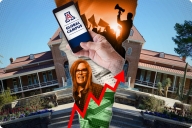You have /5 articles left.
Sign up for a free account or log in.
In the middle of the last decade, the University of Arkansas system joined the growing number of public universities striving to significantly expand their capacity to educate working learners online. With a total of just $7 million in start-up funds and money borrowed from the university’s various campuses and the system office, it created a fully separate online institution known as eVersity aimed at reaching hundreds of thousands of Arkansans who had attended college but never received a degree.
Late last month, the Arkansas system’s Board of Trustees announced that it would fold eVersity into the new institution it created when it paid $1 last summer to purchase the online, for-profit Grantham University. The combined University of Arkansas Grantham, a public institution, will have about 5,500 students, offer about 60 undergraduate and graduate degree programs, and assume and pay off the several million dollars remaining from eVersity’s original debt.
At a time when the University of North Carolina system is spending $97 million to build out an online learning platform to help its 17 institutions reach adult learners, and the University of Phoenix is expected to be sold to help one public university supercharge its online education ambitions, Arkansas’s experience may be instructive to understanding what’s possible and not for the numerous states and public universities with similar goals.
EVersity never achieved its founders’ enrollment targets or came close to break-even status financially. In an era when a handful of mega-universities have tens of thousands of students, some might write Arkansas’s effort off as a failure.
Those behind eVersity don’t see it that way, of course. Michael Moore, who ran eVersity while serving as the Arkansas system’s vice president for academic affairs, notes that despite limited funding that constrained the university’s marketing and technology investments, eVersity helped thousands of working adults earn credentials that advanced their careers and lives. And without having launched eVersity seven years ago, Arkansas would not now be in a position to absorb and operate the larger Grantham.
It would also be tempting to view eVersity as evidence that public universities can’t develop successful online operations on their own and are better off following Purdue University, the University of Arizona and others in buying (for-profits) rather than building. A 2019 report from the Manhattan Institute highlighted eVersity as an example of public universities’ general inability to build online programs of sufficient scale to compete with private nonprofit and for-profit universities for adult leaders.
“Underinvestment is the clear culprit: eVersity began with $7 million in seed investment … insufficient to build courses, secure accreditation, and adequately staff and promote the program to hundreds of thousands of Arkansans,” the report said.
Public institutions may be doing themselves—and their states and students—a disservice by defining success as competing with Southern New Hampshire University or Arizona State University, says Evangeline Tsibris Cummings, assistant provost at the University of Florida and director of UF Online, its digital learning arm.
“We have the wrong expectations for launching these online endeavors: infinitely scalable, revenue generating within the first year, bringing us into new markets with some magic pixie dust,” Cummings said. “We should instead be asking, why are we doing this, where is our unique niche and what part of our proud tradition do we want to expand in the online sphere?”
Quick History of Online Learning
While public universities enroll nearly 45 percent of all undergraduates in the U.S., they enroll barely a quarter of all students who study fully online. That population—made up disproportionately of working adults, students place-bound by family or work considerations, military service members and others—has historically been served by for-profit institutions and, more recently, by private nonprofit universities such as Southern New Hampshire and Western Governors University. Those institutions continue to dominate the list of fully online enrollments, along with a handful of public universities such as the University of Maryland Global Campus and Arizona State.
It’s not for lack of trying. Inside Higher Ed has extensively documented ambitious online education efforts by states and public university systems that fell flat (the University of Illinois, the California State University system and the University of Texas system).
That hasn’t stopped many more from taking a shot, through a variety of means. The most visible initiatives have involved institutions trying to leapfrog into size and scale by buying formerly for-profit universities, most notably Purdue University with Kaplan University and the University of Arizona with Ashford University. The University of Massachusetts’s absorption of Brandman University, a private nonprofit that was itself spun off from Chapman University, falls loosely into this category.
Others have chosen to try to build rather than buy. Institutions such as the University of Missouri at Columbia and Louisiana State University have sought to follow the models embraced by the University of Florida to build slowly from within the institution, while the California Community Colleges hoped to follow the University of Maryland model of building a separate online institution, though with significantly more money from the Legislature than most such efforts receive. The University of North Carolina’s Kitty Hawk Project is the latest high-profile effort.
Many of those initiatives have targeted the population of Americans with some college but no degree, which the latest data from the National Student Clearinghouse Research Center pegged at 39 million, the vast majority of them aged 25 to 64. Arkansas was early among them.
Changing Landscape
Even by the middle of the last decade, when Arkansas officials set their sights on building a new online institution to serve working learners in Arkansas and surrounding states, the competition was already stiffer than what they’d encountered in their previous jobs at the University of Texas at Arlington.
There, Michael Moore and UT Arlington’s then provost, Donald Bobbitt, forged an early relationship with an online program management company, Academic Partnerships, and built several highly successful online programs from the mid-2000s to the early 2010s.
When they moved together to Arkansas, with Bobbitt as system president, their vision was to “leverage the power of the system” to build a “brand-new institution from scratch, with faculty from the campuses participating only if they wanted to,” Moore said. (Some of the university's individual campuses had their own online operations, including the University of Arkansas Global Campus at the flagship Fayetteville campus, which in the 2021 academic year enabled 3,733 fully online enrollments and more than 15,000 students taking at least one online course.)
Inside Higher Ed published several articles in the last half of the 2010s laying out choices the institution made and hurdles it faced along the way in securing funding, gaining accreditation and struggling to build enrollment.
Moore and others attribute much of the difficulty eVersity faced over the years to its limited initial funding.
“Arkansas is not a wealthy state, and we had to live within our means,” Moore said. “That forced us to be very lean when deciding what programs to offer, and the institution didn’t have money to go toe to toe in marketing with better-funded online institutions.”
EVersity’s target students also created a challenge. Many universities that launch online programs focus on master’s degrees, which typically have a ready-made audience willing to pay for clearly defined credentials. EVersity focused on the some college, no degree market, said Moore, since “if you’re going to truly transform somebody’s life, getting them that first degree is what matters most.” The primary credentials for that audience are associate degrees, which require 60 or more academic credits, and bachelor’s degrees, which demand 120-plus. Master’s degrees, by contrast, typically offer 30 to 36 credits. Focusing on an audience of undergraduates who’ve previously struggled in college also requires expensive services such as tutoring, math labs and advising that graduate programs typically don’t.
The online institution had some successes, Moore says. Its programs were regularly cited for quality instruction by online education groups, and it was among the first institutions to automatically confer associate degrees to bachelor’s degree–seeking students after they’d accumulated sufficient credits and met a residency requirement.
“A bachelor’s can be a long, long, long slog, and life’s often going to happen to them along the way,” Moore said. “If they stop out at 80, 90, 95 credits, they’re no longer applying for a job saying, ‘I’m only a high school grad.’”
Ultimately, though, the enrollment figures are what they are, and Arkansas officials concluded they’d be more likely to succeed by supplementing eVersity than continuing to try to build it on its own. Grantham, which like most for-profit institutions had suffered its own enrollment losses amid regulatory scrutiny and workforce trends, presented that opportunity. Its enrollment had tumbled by half from 2014 to about 6,500 students in 2020, and the owner of the 70-year-old Kansas institution thought a nonprofit or public university would be a good “steward” for it going forward.
The transaction was valued at $1, and unlike some of the more controversial arrangements in which public universities take over for-profit institutions, like those involving Purdue and Arizona, Arkansas isn’t obligated to pay the seller for services to run the new institution.
What’s Ahead?
The Arkansas board’s formal closure of eVersity was academic; the institution had already been combined with Grantham to create the University of Arkansas Grantham, and eVersity’s enrollment had withered to 120 after several hundred students were absorbed into the new institution.
Moore is hopeful that combining eVersity with Grantham as UA Grantham will result in a stronger institution. The combined institution will have 60 academic programs (eVersity had 25), and eVersity is applying its course design chops and the efficiency it developed through lean financial years to sharpening the program focus. Grantham has stronger marketing capacity and gives every student a new laptop—“that’s the kind of thing we just could never find the money to do,” Moore said.
Still, success won’t come easily. The market has grown significantly more competitive in recent years, and “the pandemic has made it worse,” Moore said. “Every school went online, and some of them probably think, ‘We can stay here.’ But they may misunderstand how difficult it is to provide support to students at the undergrad level.”
The 2019 Manhattan Institute analysis urged more public institutions to do what eVersity tried to do: focus on adult learners, and do so by developing robust online programs “to fulfill their missions to their home states.” It suggested they must overcome their historical disinclinations to market programs heavily to would-be learners and follow up aggressively with them, and to invest significantly in that marketing.
“The up-front investment required for an effective marketing apparatus is often more than public universities, as well as the state legislatures that oversee them, are willing to commit,” the authors of the Manhattan Institute paper wrote. “But without effective promotion on the front end, online programs at public universities may not achieve the scale that they need to reduce costs and lower end prices for students. More important, these public universities will fail to achieve their mission to serve adult learners in their states.”
How Important Is Scale?
Cummings of UF Online suggests looking at public universities’ online initiatives a little differently. At a distance, the genesis of the University of Florida’s online arm looks similar to Arkansas’s: initiated by its state government (in 2013), struggles out of the gate (in its case, a failed partnership with an online program company), then slow progress but, at 4,500 students, far from the size of major online players.
“This now is a fully in-house, faculty-driven operation, and it’s a complete success to us,” said Cummings. “We have no desire to be mega.”
As Cummings watches other states and public universities contemplate going online, she worries about what she calls “the Michael Crow effect,” after the Arizona State University president who built an online powerhouse early on and has inspired numerous university leaders to try to imitate that success.
“A lot of institutions now are saying, ‘We have to go online; we have to do something,’ and they seem to think the choice is between doing nothing or trying to be massive, becoming another mega-university,” Cummings said. “There’s a nice middle there—tremendously fantastic, infinite combinations of a middle.”
That may look different at different institutions: at one university a focus on serving working adults, at another perhaps creating more flexibility for existing students to take online courses, at yet another expanding the options for former students to return to complete their degrees.
Whatever it is should be consistent with the institution’s mission.
“Are these an extension of your tradition, or are students and faculty going to see them as what they really are—a power grab into a space where you will not be competitive?” Cummings said. “There’s a lot of noise about what it means to go online post-pandemic, and it can confuse presidents and boards. It’s a cool thing to tell your board that you’re going to buy a for-profit, and it’s a space a lot of people are more familiar with: buying things, making announcements.
“What most of us really need to do is the hard work of re-envisioning campus experiences, creating new pathways to learning. That’s department by department, academic discipline by academic discipline. That’s how you build a really engaging online experience that’s authentic to your mission.”









